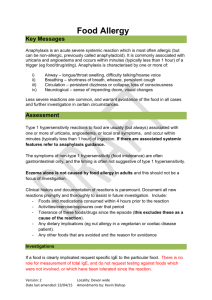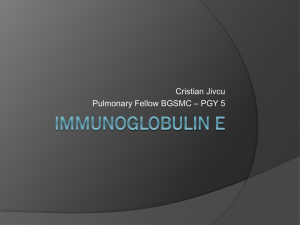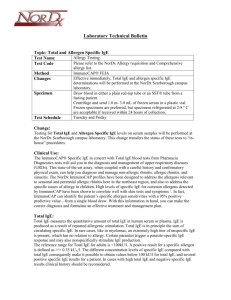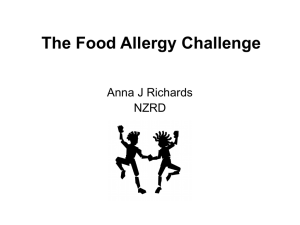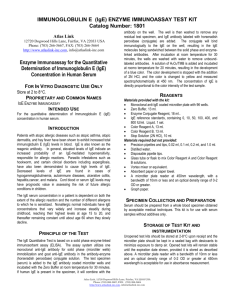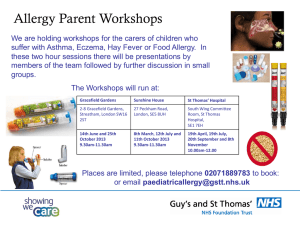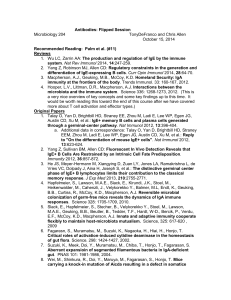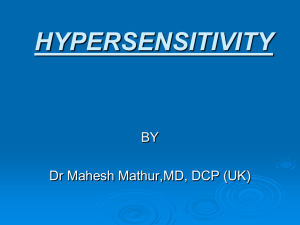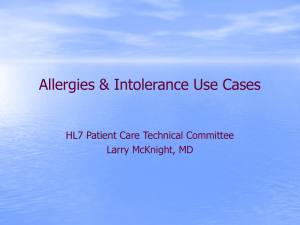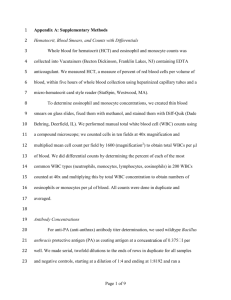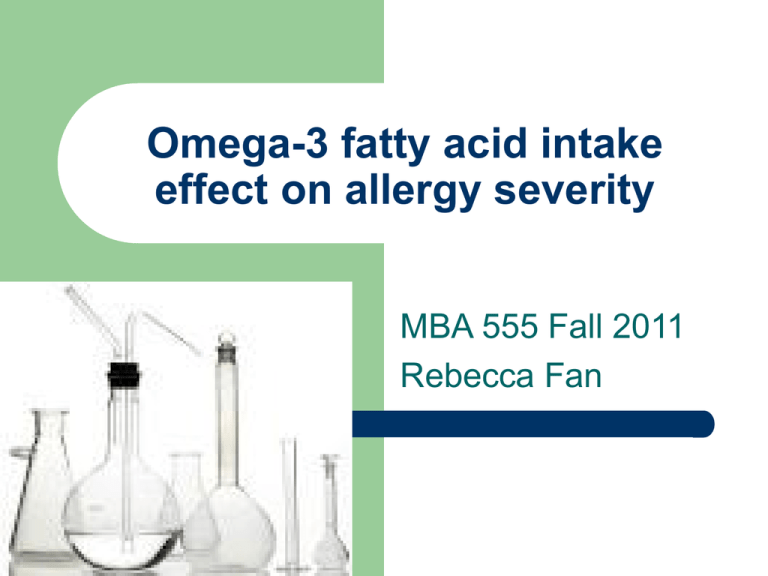
Omega-3 fatty acid intake
effect on allergy severity
MBA 555 Fall 2011
Rebecca Fan
Introduction
Epidemiological research has indicated that
allergy disease is triggered by the combination
of both genetic and environmental factors
Few studies has reported that intake of omega3 fatty acid could potentially reduce the blood
pressure and allergy severity level
Omega-3 supplementation during pregnancy
and lactation could decrease the risk of
childhood asthma; however the evidence was
not conclusive across different studies
Introduction
Serum IgE level has been recognized as the
surrogate for allergy severity level
measurement
Variations of normal total serum IgE can range
from 150 to 1,000 UI/ml; however the
acceptable upper limit is usually between 150
and 300 UI/ml
Objectives
Investigate the relationship between allergy
severity level reduction and omega-3 intake
Understand how other factors such as age,
gender, height, weight, smoking and prior
history of allergy could impact the effect
between omega-3 intake and serum IgE level
H0: Daily omega-3 intake(g/d) has a significant
effect on serum IgE level(UI/ml), either positive
or negative (two-sided test)
Data source and study population
De-identified data from an allergy treatment
clinical trial (on-going)
46 individuals with complete demographic
information collected including: age, height,
weight, gender (1=male;2=female), smoking
status (1=yes;0=no), and previous allergy
history (1=yes;0=no)
Analysis
Software tool: WinORS
Models - Ordinary Least Square (OLS)
- Multiplicative model was applied to
log transformed data in order to
estimate the impact of % change in
serum IgE level in responding to %
change in omega-3 intake
- Weighted Least Square (WLS)
Result - OLS
White's Test for Homoscedasticity:P=0.14479
Result - OLS
Normality test:P=0.987, Average VIF=1.491
Result – Multiplicative Model
Elasticity parameter estimates:
Parameter Standard t For Ho:
Variable
Estimate
Intercept
6.987
OMEGA3(g/d)
-0.757
SEX
-0.352
PrevHis
0.292
Dependent: IgE(UI/ml)
Error
0.359
0.191
0.188
Est = 0
-2.11
-1.846
1.549
Avrg.VIF
P-Value
(95%=0.05)
CI Lower CI Upper
95%
95%
4.97
9.004
0.0384
0.06848
0.125
-1.481
-0.737
-0.088
-0.033
0.033
0.671
1.47
R-Squared
35.60%
Result – WLS
Elasticity parameter estimates:
Variable
Parameter Standard t For Ho: P-Value CI Lower CI Upper
Estimate Error
Est = 0 (95%=0.05)
95%
95%
Intercept
6.764
OMEGA3(g/d) -0.76
SEX
-0.245
PrevHis
0.425
Dependent: IgE(UI/ml)
0.142
0.155
0.081
0.073
47.506
-4.913
-3.019
5.803
0.00001
0.00007
0.00448
0.00002
6.477
-1.072
-0.408
0.277
7.051
-0.448
-0.081
0.572
Partial
Corr
VIF
0.982
n/a
-0.371
3.725
-0.182
1.422
0.451
1
R-Squared 99.97%
Conclusion and implication
Elasticity of IgE level = 6.764+ (-0.76)*omega3(g/d) + (-0.245)*SEX + (0.425)*PrevHis
Recommendation for nutrition intake: 10%
increase in daily omega-3 intake could help to
reduce serum IgE level by 8%
Gender variable suggested a protective effect
for female (lower IgE level compare with same
condition male), possibility because women in
general are more health conscious than man
References
Ann Med Interne (Paris). 1985;136(5):419-22. Laurent J et al. How to
define the normal level of serum IgE in adults?
Acta Paediatr. 2009 Sep;98(9):1461-1467. Furchjelm C et al. Fish oil
supplementation in pregnancy and lactation may decrease the risk of
infant allergy.
BJOG 2011 Jul;118(8):916-25. doi: 10.1111/j.1471-0528.2010.02846.x.
Klemens CM et al. The effect of perinatal omega-3 fatty acid
supplementation on inflammatory markers and allergic diseases: a
systematic review.
Fur M Med Res. 2009 Dec 7;14 Suppl 4:248-54. Wilczyska-Kwiatek A et
al. Asthma, allergy, mood disorders, and nutrition.
Allergy. 2009 Jun;64(6):840-8. Epub 2009 Apr 7. Anandan C et al. Omega
3 and 6 oils for primary prevention of allergic disease: systematic review
and meta-analysis.

